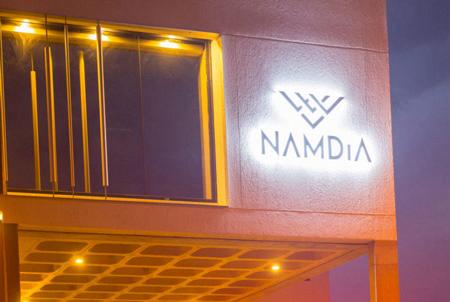DIAVIK MINE – Once a hotbed of gold mining, Canada’s far north is now unearthing riches from a different precious commodity: diamonds.
At the Diavik mine, just over 200 km south of the Arctic Circle, a 200-metre-deep crater pierces a frozen-white tundra, yielding some of the purest diamond deposits known. “They’re among the three best pipes in the world, by value per tonne,” spokesman Tom Hoefer said of the kimberlite pipes – vertical columns of diamond-bearing rock – the mine is currently working.Hoefer relates a story – true, he says – of a drill that was pulled from the ground with a sizable diamond stuck right on the bit.It is a far cry from the Klondike gold rush in neighbouring Yukon territory, which drew tens of thousands of prospectors over three years starting in 1896.The Diavik mine is located on an island in icy pure Lac de Gras, a lake in Northwest Territories.The lake has been diked and partially drained to open access to the ore below.Power is generated on-site and supplies are trucked in on an ice road that’s open barely 10 weeks a year.Temperatures are so low that truck axles can suddenly become brittle and snap.But the result is worth the challenges and costs.The mine produces clear, white stones of jewellery rather than industrial quality and yields are about three carats per tonne, three times the industry average.Last year, it produced 11,9 million carats, roughly 10 per cent of global output and a little more than a third of the annual production of Rio’s Argyle mine in Australia, the world’s largest producer by volume.Total capital and operational spending on the mine has reached US$3,2 billion, including US$563 million for an underground expansion that should keep it running past 2020.A second pit is expected to start producing diamonds soon.The mine is operated by a subsidiary of Rio Tinto, which markets 60 per cent of the take, while 40-per cent stakeholder Harry Winston Diamond markets the rest.HIGH-SECURITY At first glance, the presence of diamonds at the mine would appear to be a myth.The mined kimberlite has barely one part per million of actual diamond, and the final stages of the processing plant are shrouded in secrecy, with guards accompanying the few workers allowed inside.Visitors and workers are put through an airport-style security check both on the way in and on the way out, checking for smuggled drugs and alcohol on the way in, and errant diamonds on the way out.Once past security, however, the site has all the comforts of home, with single rooms for miners, an indoor gym and running track, and a wealth of extracurricular activities for miners, who spend two weeks at a time living at the site.”It’s like being on a cruise ship,” says Marion Evans, who works at the adult education facility at the mine, designed to give workers a leg-up in training for better positions.A glance out the window at surroundings shrouded in ice fog shatters the cruise ship analogy.Standing atop a dike at the 700-metre-wide South pit, the minus 37 degrees Celsius temperature feels 20 degrees colder in the wind.Any exposed skin is excruciatingly painful.Two hundred metres below, seven-metre-high dump trucks haul 250-tonne loads of mined kimberlite up a winding road to the processing plant.Nampa-Reuters”They’re among the three best pipes in the world, by value per tonne,” spokesman Tom Hoefer said of the kimberlite pipes – vertical columns of diamond-bearing rock – the mine is currently working.Hoefer relates a story – true, he says – of a drill that was pulled from the ground with a sizable diamond stuck right on the bit.It is a far cry from the Klondike gold rush in neighbouring Yukon territory, which drew tens of thousands of prospectors over three years starting in 1896.The Diavik mine is located on an island in icy pure Lac de Gras, a lake in Northwest Territories.The lake has been diked and partially drained to open access to the ore below.Power is generated on-site and supplies are trucked in on an ice road that’s open barely 10 weeks a year.Temperatures are so low that truck axles can suddenly become brittle and snap.But the result is worth the challenges and costs.The mine produces clear, white stones of jewellery rather than industrial quality and yields are about three carats per tonne, three times the industry average.Last year, it produced 11,9 million carats, roughly 10 per cent of global output and a little more than a third of the annual production of Rio’s Argyle mine in Australia, the world’s largest producer by volume.Total capital and operational spending on the mine has reached US$3,2 billion, including US$563 million for an underground expansion that should keep it running past 2020.A second pit is expected to start producing diamonds soon.The mine is operated by a subsidiary of Rio Tinto, which markets 60 per cent of the take, while 40-per cent stakeholder Harry Winston Diamond markets the rest.HIGH-SECURITY At first glance, the presence of diamonds at the mine would appear to be a myth.The mined kimberlite has barely one part per million of actual diamond, and the final stages of the processing plant are shrouded in secrecy, with guards accompanying the few workers allowed inside.Visitors and workers are put through an airport-style security check both on the way in and on the way out, checking for smuggled drugs and alcohol on the way in, and errant diamonds on the way out.Once past security, however, the site has all the comforts of home, with single rooms for miners, an indoor gym and running track, and a wealth of extracurricular activities for miners, who spend two weeks at a time living at the site.”It’s like being on a cruise ship,” says Marion Evans, who works at the adult education facility at the mine, designed to give workers a leg-up in training for better positions.A glance out the window at surroundings shrouded in ice fog shatters the cruise ship analogy.Standing atop a dike at the 700-metre-wide South pit, the minus 37 degrees Celsius temperature feels 20 degrees colder in the wind.Any exposed skin is excruciatingly painful.Two hundred metres below, seven-metre-high dump trucks haul 250-tonne loads of mined kimberlite up a winding road to the processing plant.Nampa-Reuters
Stay informed with The Namibian – your source for credible journalism. Get in-depth reporting and opinions for
only N$85 a month. Invest in journalism, invest in democracy –
Subscribe Now!










